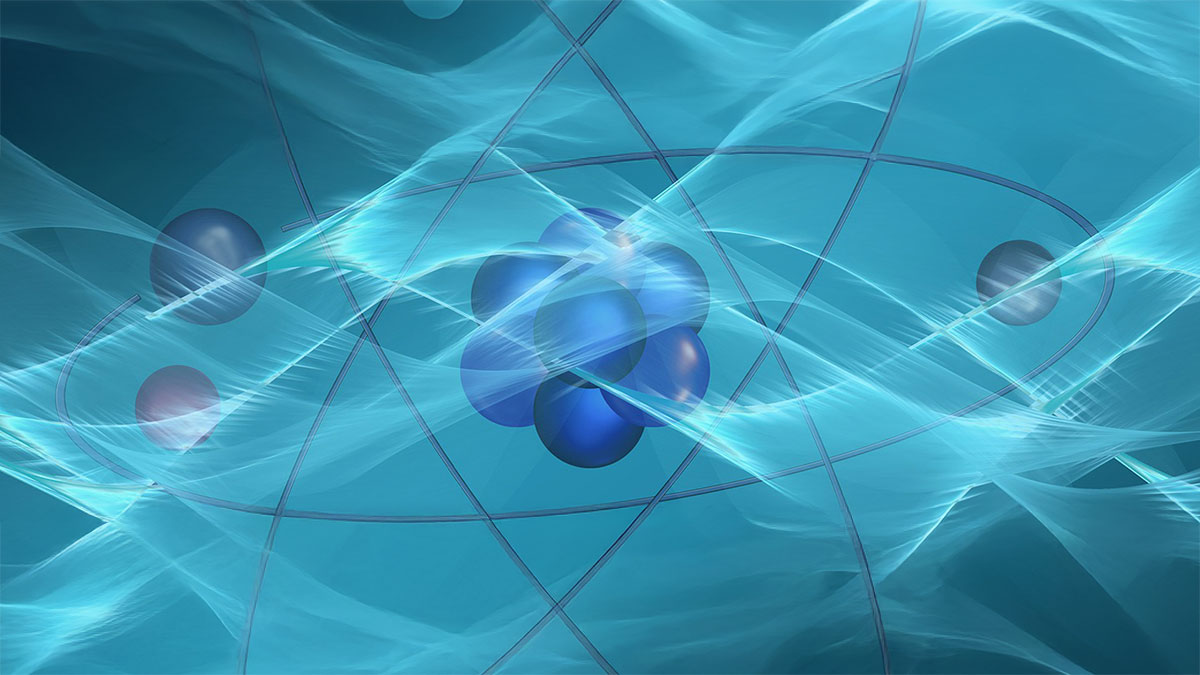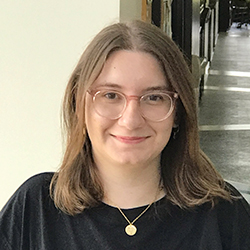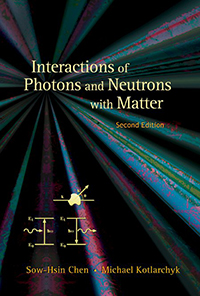Kotlarchyk-Thurston-Dholabhai Research Group

Kotlarchyk/
Thurston/
Dholabhai
Research Group
Combining Nuclear Magnetic Resonance and Neutron Scattering for Determining Macromolecular and Liquid Structure: Towards Development of the Novel NMR-PNS Technique.
Research Overview
With support from the National Science Foundation (NSF) Chemical Measurement and Imaging Program in the Division of Chemistry,* Professors Michael Kotlarchyk, George Thurston, and Pratik Dholabhai at RIT are developing a powerful next-generation technique, spin-modulated neutron scattering, with the potential to non-invasively probe nanoscale structure, molecular arrangements, and dynamics in liquids with an unprecedented combination of selectivity, high resolution, and spatial range.
By manipulating nuclear spins via Nuclear Magnetic Resonance (NMR) to take advantage of the dramatic spin-dependence of Polarized Neutron Scattering (PNS), structures and dynamics of molecules, molecular assemblies, and solutions can be probed. This novel technique of Nuclear Magnetic Resonance – Polarized Neutron Scattering, or NMR-PNS, has the potential to revolutionize the detailed, molecular-scale information available for a broad variety of materials, from liquid mixtures to catalysts to novel nanomaterials to biological macromolecules. The information to be gained is crucial for predicting and rationalizing many processes of industrial, medical, and societal importance including binding, catalysis, and phase transitions.
The project focuses on calculational modeling as a foundation for future development of experimental methods. The team is extending the quantum-mechanical density-operator treatment of NMR-PNS to treat spin relaxation, spin coupling, and the incorporation of nuclei with any quantum spin. This will enable the prediction and simulation of PNS cross sections and signal-to-noise ratios for hyperpolarized molecules in solution and for molecules prepared via specialized NMR protocols.
Molecular dynamics simulations of molecules hyperpolarized in solution via Signal Amplification by Reversible Exchange (SABRE) are being undertaken to permit quantitative evaluations of site-site spatial correlations in solution, which are essential for predicting the PNS signal and for a rigorous statistical analysis of PNS signal-to-noise. NMR protocols that apply selective pulse-shaping and sequencing to hyperpolarized molecules will be designed and simulated, thereby enabling use of the correlation functions to evaluate the resulting polarized neutron scattering cross-sections.
Finally, complete statistical analyses of putative NMR-PNS protocols for SABRE-hyperpolarized molecules will be performed. The simulated scattering signals will inform the design of effective NMR-PNS instrumentation and experiments, including sample environment, beamline, and detector parameters. The ultimate aim is to determine structure factors between atomic pairs selected via NMR spin-manipulation, from sub-angstrom to micron length scales, thereby giving valuable information about molecular conformations and relative orientations in solution. The SABRE-PNS methods to be developed are important stepping-stones towards full NMR-PNS and will be valuable in their own right.

Michael Kotlarchyk is a professor and head of the RIT School of Physics and Astronomy in the College of Science. His research interests include (1) Thermal neutron, x-ray, and laser-light scattering to investigate the structure, interactions, and phase behavior of self-assembled complex fluids (2) Small-angle Neutron (SANS) and X-ray Scattering (SAXS), Neutron Spin-echo (NSE), Dynamic Light Scattering (DLS) (3) Theoretical framework for mapping detailed structure of macromolecules, such as large proteins, by the combined use of NMR nuclear spin-manipulation techniques and polarized neutron scattering as a spin-dependent atomic probe.

George Thurston is a Professor and Director of the MS Physics program at the RIT School of Physics and Astronomy. His research interests are in the areas of chemical and biological physics, and many topic areas are inspired by the need to better understand the molecular basis of phase transitions arising in protein condensation diseases, including cataracts. His group uses techniques including quasielastic and static light scattering, X-ray scattering, neutron scattering, nuclear magnetic resonance, and Monte Carlo methods applied to micellar, protein, and nucleic acid solutions, and develops statistical thermodynamic models for the observed phenomena. Ongoing projects include studies of concentrated mixtures of eye lens crystallin proteins related to cataracts, studies of the eye lens vitreous, development of light scattering methods for noninvasive determination of multicomponent free energies of mixing, and development of methods for combining neutron scattering and nuclear magnetic resonance to refine structural information about macromolecular liquids.

Pratik Dholabhai is an assistant professor of physics at the RIT School of Physics and Astronomy. His expertise is in applying atomistic simulation methods such as density functional theory and molecular dynamics and the development of kinetic Monte Carlo methods to study and design diverse materials. His research focuses on integrating fundamental physics, materials science, and chemistry in conjunction with state-of-the-art computational tools to investigate materials for a wide range of applications.
Research Students

Stella Van Ness
MS Physics Student
Email
MS Thesis: Analysis of Molecular Dynamics Simulations Relevant to Combining Polarized Neutron Scattering with Nuclear Magnetic Resonance (Submitted/Certified December 2023)

Nicolas Sovare
MS Physics Student
Email
Capstone Project: Polarized Neutron Scattering From a Prototype Spin-Modulated Molecule Dissolved in Solution (in progress)
Collaborators
Expertise in NMR techniques.
Expertise in NMR techniques.
Expertise in implementation of SABRE-hyperpolarized NMR.
Simon Duckett
Professor of Chemistry
Director, Centre for Hyperpolarisation in Magnetic Resonance
University of York, UK
Select Scholarship
M. Kotlarchyk and G.M. Thurston, A Framework for Modeling Polarized Neutron Scattering from NMR Spin-Modulated Systems, Journal of Physics: Conference Series 862 (2017) 012015. doi:10.1088/1742-6596/862/1/012015
M. Kotlarchyk, and G. M. Thurston, Basis for Calculating Cross Sections for Nuclear Magnetic Resonance Spin-Modulated Polarized Neutron Scattering, Journal of Chemical Physics 145 (2016) 244201. doi:10.1063/1.4972994
2025 International Conference on Neutron Scattering, Copenhagen, Denmark
Presented by M. Kotlarchyk, July 8, 2025
Initial Modelling of Time-Dependent Angular Cross Sections Arising From Continuous RF Irradiation During NMR Spin-Modulated Neutron Scattering From Selectively-Hyperpolarized Molecular Solutions
M. Kotlarchyk, G.M. Thurston, and N.J. Sovare
XIX international Small Angle Scattering Conference, Taipei, Taiwan
Presented by M. Kotlarchyk, November 13, 2024
Scattering From Hyperpolarized and Spin-Manipulated Molecular Solutions—Simulation, Theory, and Feasibility
M. Kotlarchyk, G.M. Thurston, and P.P. Dholabhai
2024 American Conference on Neutron Scattering, Knoxville, TN
Presented by G. Thurston, June 25, 2024
Molecular Dynamics Simulations to Evaluate the Potential for NMR-modulated Polarized Neutron Scattering from Hyperpolarized Molecules in Solution
G. Thurston, S. Van Ness, P. Dholabhai, and M. Kotlarchyk
2022 International Conference on Neutron Scattering, Buenos Aires, Argentina
Poster presented (virtually) by M. Kotlarchyk, August 22, 2022
On Selectively Extracting Intra- and Intermolecular Atomic Correlations on the Basis of Polarized Neutron Scattering from Spin-Manipulated Hyperpolarized Molecules in Solution
M. Kotlarchyk and G.M. Thurston
14th International Conference on Polarized Neutrons for Condensed Matter Investigations, Annapolis, MD
Presented by G.M. Thurston, July 27, 2022
Towards Realization of NMR-Modulated Polarized Neutron Scattering From Hyperpolarized Solutes
G. Thurston, P. Dholabhai, M. Kotlarchyk, S. Van Ness, and J. Knapp
2022 March Meeting of the American Physical Society, Chicago, IL
Presented (virtually) by M. Kotlarchyk, March 17, 2022
Calculation of Polarized Neutron Scattering Cross Sections from Prototypical Spin-Manipulated Hyperpolarized Molecules in Solution
M. Kotlarchyk and G. Thurston
2022 March Meeting of the American Physical Society, Chicago, IL
Presented (virtually) by G.M. Thurston, March 17, 2022
Use of Molecular Dynamics Simulations to Study Signal-to-Noise Aspects for Obtaining Polarized Neutron Scattering Cross Sections
G.M. Thurston, P.P. Dholabhai, and M. Kotlarchyk
2020 American Conference on Neutron Scattering (virtual)
Poster presented by G. Thurston, July 14, 2020
Towards Enhanced Neutron Scattering from Spin-Hyperpolarized Substrate Molecules: Calculations and Simulations
G. Thurston and M. Kotlarchyk
2019 March Meeting of the American Physical Society, Boston, MA
Presented by M. Kotlarchyk, March 7, 2019
Cross-Section and Measurement Considerations for Polarized Neutron Scattering from NMR Spin-Modulated Systems
M. Kotlarchyk and G. Thurston
Invited Talk: Oak Ridge National Laboratory, Knoxville, TN
Presented by M. Kotlarchyk, May 30, 2018
Basis for Calculating Cross-Sections for Nuclear Magnetic Resonance Spin-Modulated Polarized Neutron Scattering
M. Kotlarchyk and G. Thurston

Graduate-level textbook: Interactions of Photons and Neutrons with Matter, 2nd edition, S.H. Chen and M. Kotlarchyk (World Scientific, 2007)
This invaluable book is based on lecture notes developed for a one-semester graduate course entitled “Interaction of Radiation with Matter”, taught in the Department of Nuclear Science and Engineering at the Massachusetts Institute of Technology. The main objective of the course is to teach enough quantum and classical radiation theory to allow students in engineering and the applied sciences to understand and have access to the vast literature on applications of ionizing and non-ionizing radiation in materials research.
Besides presenting the fundamental physics of radiation interactions, the book devotes individual chapters to some of the important modern-day experimental tools, such as nuclear magnetic resonance, photon correlation spectroscopy, and the various types of neutron, x-ray, and light-scattering techniques. End-of-chapter problems have been added for the new edition, making the book more appropriate as a course textbook.
Acknowledgement
*This material is based upon work supported by the National Science Foundation (NSF) under Award No. 2108977.
Any opinions, findings, conclusions, or recommendations expressed in this material are those of the author(s) and do not necessarily reflect the views of the National Science Foundation.
The use of materials such as images and data appearing on this webpage should be acknowledged appropriately by attributing such to this website.





